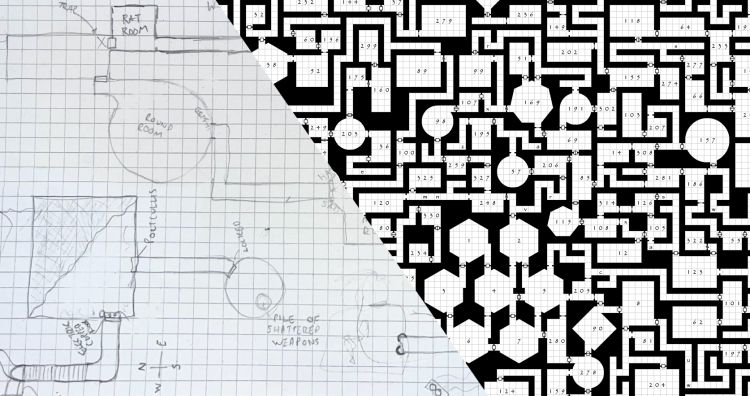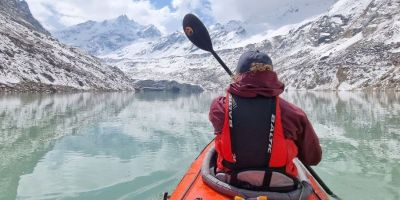Tabletop role-playing games offer insight into how we think about spaces

Dr Asa Roast explores the “megadungeon” – an imagined space that players of fantasy tabletop role-playing games (TTRPGs) play in – using critical geography.
Dr Roast recently spoke at the conference “Megadungeon: New Digital Volumetries in Art and Media” at Ca’ Foscari University of Venice about his insights.
He joined anthropologists, art historians and media experts to explore new ways of seeing and learning from the megadungeon.
In 2022, academics came together at a Leeds Arts and Humanities Research Institute (LAHRI) Sadler Series called “Serious Play: Exploring Role-Playing Games as Practice-Led Research.”
They created the podcast “Serious Play” in which they spoke about tabletop role-playing games and their academic implications with experts.
This connection led Dr Roast to talk at the recent conference in Venice and to contribute to the special issue, “Megadungeon,” published by Venice University Press.
Watch 'In Search of the Unknown: Urbanising the Megadungeon (Asa Roast)' on YouTube.
What is the megadungeon?
In TTRPGs, such as Dungeons & Dragons, players collectively imagine the space in which their characters act and advance their game. This is often a dungeon, which is structured as a network of connected chambers. Each space contains challenges that players must overcome.
The megadungeon describes one of these spaces that is so big that it’s impossible for the players to ever finish exploring it.
Dr Roast says that the megadungeon is a complex, interconnected "representation of space.” Its structure and the way people navigate it can mirror other non-physical spaces like digital media.
By analysing the megadungeon’s interconnected layers, Dr Roast examines the nature of imagined human spaces in general.
Exploring them through a geographical lens adds a new understanding to the games and can enrich geographical concepts.
Navigating imagined spaces
In these TTRPGs, there are rules and limits to the gameplay. Many of these are imposed by the imagined landscape. For example, if there is a monster in the same chamber as they player, they must interact.
Players must engage with the space and use it to help them advance. As it’s imagined, they may use the space in interesting and unexpected ways.
The terrain could be an obstacle, or it can be used as a resource itself.
The ways in which players navigate the megadungeon, a space of limitless possibility, can be reflected in the ways that people gain knowledge of new physical and digital spaces.
For example, the format and functions of certain social media platforms can act as a structure for them to be used in a certain way. Users’ control over them is limited.
However, like the imagined spaces of tabletop role-playing games, individuals invent new ways of exploring the platforms and using their functions as resources rather than constraints.
Uses in geography
In his paper, Dr Roast also makes the comparison between the chambers and enclosures of the megadungeon and national borders, incarceration and resource extraction.
These are two examples of the ways that these insights can translate to geographical study.
His special issue paper is titled “A Preliminary Geography of the (Mega)Dungeon Spatial Practice and Tabletop Role-Playing Games.” In it, Dr Roast writes:
“There are broader implications here for how spatial knowledge can be conveyed in novel and original ways: could we ask geographers to represent a field site through a megadungeon, or incorporate TTRPG practices into their fieldwork?”
Understanding representations of space such as the megadungeon can be particularly useful to geographical study when the physical area of study is unconventional in some way.
In his central research, Dr Roast explores Chinese urbanism. He studies locations on the edges of cities like Chongqing which are becoming urbanised as the cities expand.
Despite the changes, the people who live there continue to use the space in the same ways as they have previously.
Dr Roast explores this his research including the paper “Theory from Empty Land: Informal Commoning Outside/Within Economies and Ecologies of the Urban.” He examines how urbanised citizens in Chongqing have informally used vacant land to grow crops, recycling sewage and water from the city into fertiliser.
Another example is high-rise housing. While high-rises can be associated with futuristic urbanism, they can also mirror traditional housing forms.
In his paper “Towards weird verticality: The spectacle of vertical spaces in Chongqing,” Dr Roast examines the contrasts between futuristic and traditional high-rise architecture in the city and how they are influenced Chongqing’s mountainous terrain.
Their way of living and working then disrupts conventional, Western understandings of cities and rural spaces.
Dr Roast says, “In the same way, understanding the megadungeon is a process that provokes a different understanding of space that can challenge preconceived notions.”




